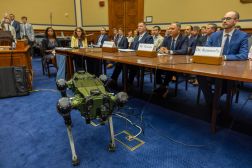Pentagon’s No. 2 warns top brass of ‘hybrid warfare’ dangers
Deputy Secretary of Defense Robert Work warned the Army’s top leaders Wednesday that future “hybrid wars” involving everything from precision artillery to electronic and cyber warfare will make it increasingly difficult for U.S. forces to prevail in combat unless the Pentagon works closely with the private sector to fully embrace the so-called “Third Offset Strategy” for technological superiority.
In one of the most detailed descriptions to date on the changing operational requirements facing the post-Afghanistan military, Work told a gathering of senior leaders at the Army War College in Carlisle, Pennsylvania, Wednesday that the growth of information technologies has led to a “proliferation of precision” in warfare that the U.S. must be capable of matching and defeating. In many ways, the military must get back to the basics of combined arms and maneuver warfare, he said, while introducing game-changing, IT-enabled technologies.
“If the streets of Baghdad and the valleys of Afghanistan were a laboratory of irregular war, I believe that ground forces will increasingly need to prepare for future hybrid war,” Work said. He described hybrid war as a blending of methods of war, where the distinction between conventional and irregular war is blurred and where precision-guided weapons proliferate.

A RQ-8A Fire Scout tactical unmanned aerial vehicle prepares to conduct the first autonomous landing at sea aboard the USS Nashville in the Atlantic Ocean, Jan. 17, 2006. (Kurt Lengfield/Navy)
In the future, U.S. forces must be ready to confront state and nonstate adversaries capable of deploying not only GPS-enabled mortars and artillery but also laser-guided weapons and an array of electronic warfare threats, according to Work.
“What is the linkage between these different levels of warfare? It’s precision-guided munitions and what Chinese military theorists call ‘informationized warfare,'” Work said. “That is, achieving information dominance using cyber and EW [electronic warfare] weapons. These are high-end weapons used by state-backed proxy forces, and we must prepare to fight this type of adversary. Doing so will require two things: Our troops will have to be even better at fire and maneuver battle drills, and we must provide them with the capabilities to overcome these threats.”
Offset strategies?
What may have come to a surprise to some, Work referenced not one but many so-called offset strategies that may be required in the future.
“Combining the finest trained troops with the best technology we can offer is exactly what we’re doing with the Third Offset Strategy, or more accurately ‘Offset Strategies,’ because these complex adversaries will demand unique strategies,” he said.
Work made specific reference to the Russian-backed proxy war in Ukraine as “a laboratory of future 21st-century land warfare,” where separatists have leveraged Russian military capabilities in precision-guided artillery, imaging and persistent electronic warfare assets.
“The American way of war we’ve grown accustomed to over the past three decades — based on dominance in precision-guided munitions — has reached the end of its shelf life. Look, our enemies have gone to school on us at least since 1991’s Desert Storm — and they’ve adapted,” Work said.
A former Marine artillery officer, Work called on the military services to “reinvigorate” its combined arms expertise and develop new ways of fighting — what he referred to as AirLand Battle 2.0. First developed in the early 1980s, AirLand Battle focused on attacking an enemy’s follow-on forces. “With version 2.0 we must be able to strike much deeper — all the way to an adversary’s command and control, reconnaissance, and targeting networks. We’ll use cyber, EW, and long-range strike to take down an adversary’s battle networks and then maneuver against him from multiple directions,” Work said.

Air Force Airman Gevoyd Little, a member of the 447th Explosive Ordnance Disposal, operates his remote explosive detection robot during Operation Falcon Sweep in Iraq in 2006. (Staff Sgt. Kevin L. Moses Sr./Army)
Robotic squads
One of the main concepts for small unit operations Work emphasized includes the ability of widely dispersed forces to use IT to quickly come together in force to strike at a time and place of their choosing. Work called it “disaggregated networked operations.” In Afghanistan, one Marine battalion of several hundred Marines was known to have dispersed across 77 miles.
“If we combine well-trained cohesive teams with new advances in robotics, autonomy, and unmanned systems, we can create super-empowered small units with enhanced situational awareness and lethality,” Work said, referring to the Defense Advanced Research Projects Agency’s Squad X program and its focus on increasing human and machine collaboration. That effort includes research into using ground robots and small micro-drones to enhance a small unit situation awareness.
“I’m convinced that increasingly we’ll see human-machine teams working together, harnessing the cognitive advantages of both human and machine,” Work said. “A freestyle form of combat that combines the agility of human cognition with the speed of computer processing may very well prove superior to human or machine alone.”
As research continues to make progress in areas like self-driving cars, Work envisions a future military force consisting of human and robot soldiers. “Robots are fighting multipliers, extending human sensory abilities and physical strength. In the not-too-distant future, squads will operate with robotic support: robot porters, sapper robots, countermine robots, counter-sniper robots,” he said.
But many of these new technologies will not be plug-and-play; they will require the military to adapt and change its concepts of doctrine and organization to seize these opportunities, Work said. “Change can be unsettling and adaptation with the department will be difficult, but it is absolutely necessary.”






